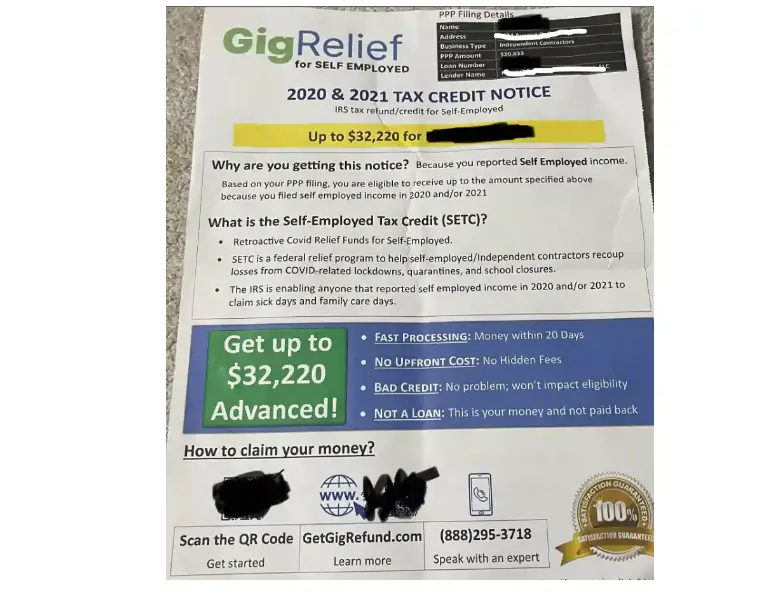In this post, we will examine the website’s questionable practices, uncover how the fraud operates, and offer tips on protecting yourself from similar scams.

Overview of GetGigRefund.com
GetGigRefund.com claims to provide COVID-19 relief funds to self-employed individuals who earned income in 2020 and 2021 through the Self-Employed Tax Credit (SETC).
However, reports suggest that users have received strange messages containing personal details like loan numbers and PPP amounts. This raises concerns that GetGigRefund.com may be a scam aiming to collect personal and financial information.
How Does GetGigRefund.com Refund Scam Work?
First of, the GetGigRefund.com scam targets self-employed individuals by sending unsolicited emails or letters that falsely claim eligibility for large COVID-19 tax credits.
Scammers use fake logos and official language to appear legitimate. Interested victims are directed to a website where they provide personal details like Social Security numbers and bank information.
The scammers then promise refunds of up to $32,000 to gain trust and extract more personal data.
Once they have this information, they can commit identity theft, access bank accounts, or engage in other fraudulent activities.
GetGigRefund.com Scam
Experts identify GetGigRefund.com’s main issue as its promotion of a fake “Self-Employed Tax Credit,” which the IRS confirms does not exist.
While the IRS offers legitimate credits for self-employed individuals, such as Credits for Sick Leave and Family Leave, these have specific eligibility criteria and are not as broadly available or lucrative as advertised by GetGigRefund.com.
By falsely claiming refunds of up to $32,000, GetGigRefund.com misleads people and tricks them into disclosing personal and financial information.
How To Protect Yourself From These Scams?
To safeguard yourself from scams like GetGigRefund.com:
- Always confirm tax-related claims with the IRS or a trusted tax professional rather than relying on unsolicited emails or messages.
- Report any suspicious communications to the IRS, FTC, or relevant authorities promptly to help prevent further scams and protect others.
- Keep up with the latest scam warnings from the IRS and other agencies to recognize and avoid evolving fraudulent tactics.
By staying vigilant and proactive, you can protect yourself and others from falling victim to scams.
READ MORE —–
- Katz Privacy Settlement Email Scam
- Omaha Steak Sample Deal Facebook Scam
- Massachusetts Toll Services Text SCAM